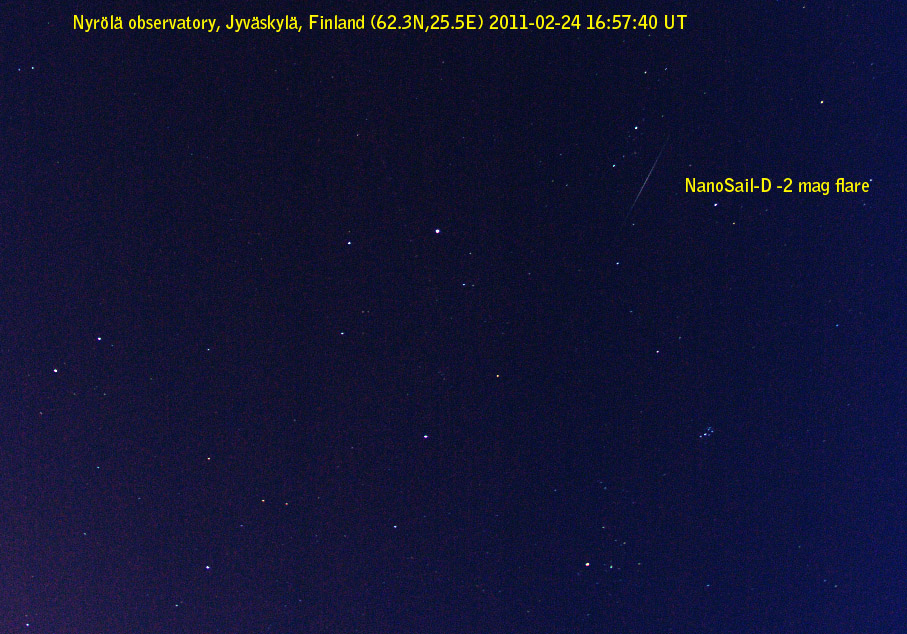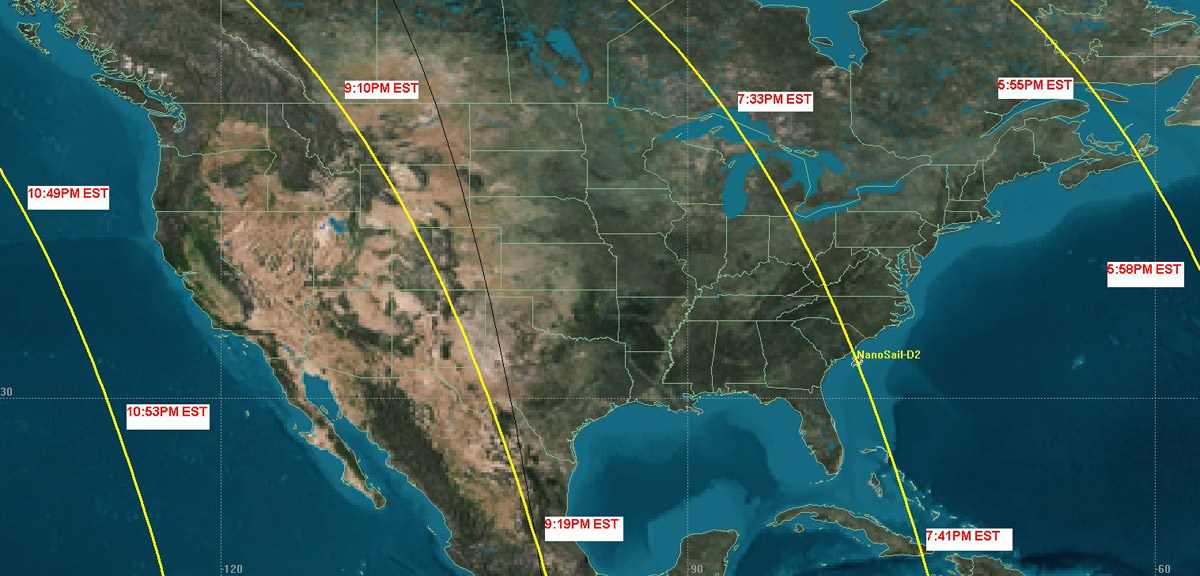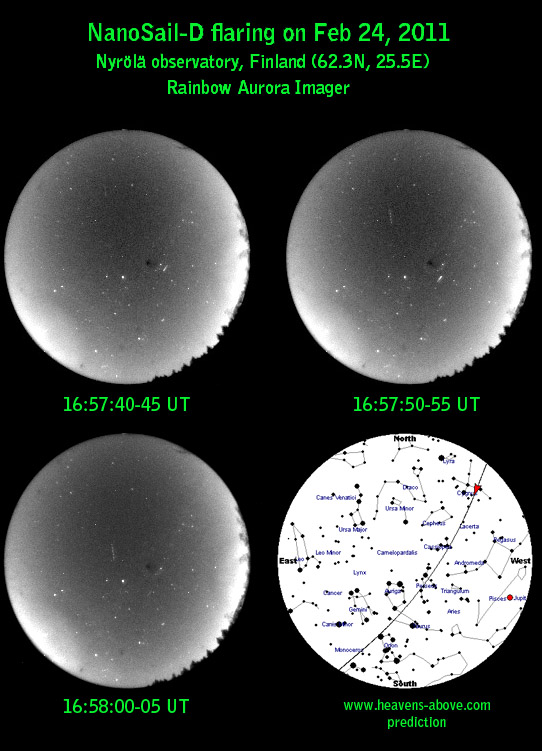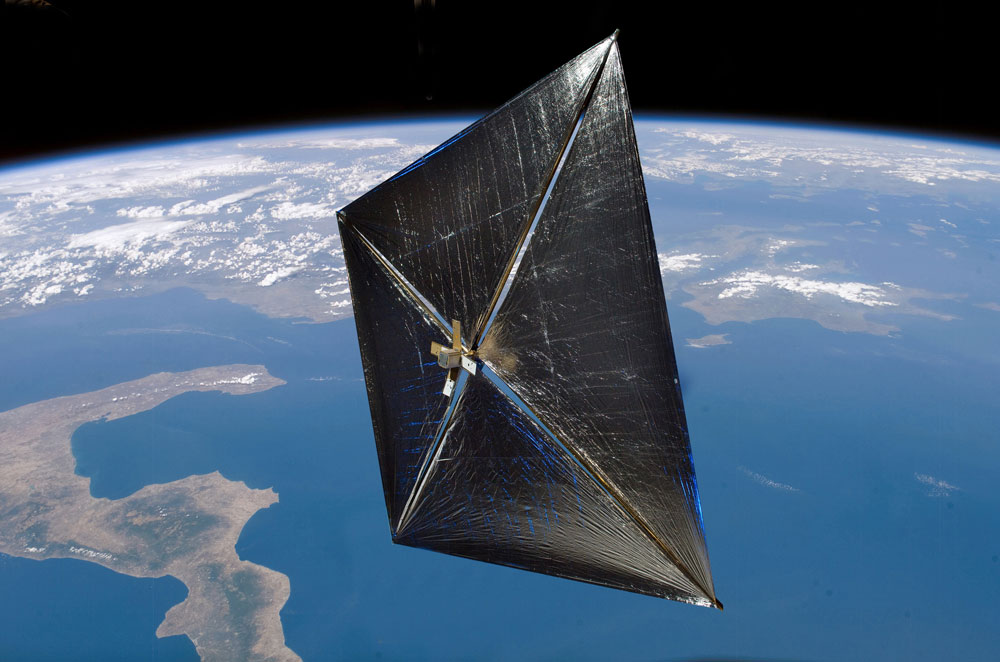NASA Solar Sail Visible Over Parts of U.S. and Canada

NASA's first solar sail to circle Earth in low orbit is making regular evening passes over much of the United States and Canada over the next week, and may be visible to skywatchers if conditions are clear.
The solar sail satellite, called NanoSail-D, is making promising passes over the 48 contiguous U.S. states and southern Canada through Monday, March 7.
NASA launched NanoSail-D in November and the satellitesuccessfully deployed its 100-square-foot polymer sail in low-Earth orbit on Jan. 20 after weeks of delay. NASA officials expect the solar sail to stay in low-Earth orbit until at least April 1 – possibly through mid-May – depending on atmospheric conditions. [Photos: Spotting Spaceships and Satellites]
If you have not yet seen it, this week’s series of evening passes will likely give observers their best opportunity to sight this most unusual artificial satellite.
This is great news for die-hard skywatchers, since NASA and the skywatching website Spaceweather.com are holding a NanoSail-D space photography contest for the best photos of the solar sail as it soars across the night sky. First prize is $500.
What to look for
Trying to actually see NanoSail-D as it passes over your location will be a bit more difficult than trying to make a sighting of the International Space Station or one of the thousands of other man-made objects currently orbiting our planet.
Breaking space news, the latest updates on rocket launches, skywatching events and more!
For one thing, unlike a typical satellite, NanoSail-D is a flat one-dimensional object. Like all orbiting satellites, visibility will depend on how much sunlight is illuminating it at any given moment.
Astronomers measure an object's brightness in space on a reverse scale called magnitude. The lower the number of an object's magnitude, the brighter it appears in the sky. [How to Spot Satellites in Space]
So far, most observers who have gotten a look at the sail as it moved across their local sky have described it as relatively dim, with brightness estimates ranging from magnitude +4 to +8.
To give you an idea of what this range means, under a dark, moonless sky, the threshold for naked eye visibility is considered to be magnitude +6.
So a magnitude +4 object would appear rather faint to the unaided eye. An object of magnitude +8 would only be visible using binoculars or a small telescope.
But other observers have reported seeing NanoSail-D appear to briefly "flash" or "flare" into easy visibility, becoming as bright as magnitude +2 which is equal to Polaris (the North Star) in brightness.
Solar sail "flares"
Such sudden increases in brilliance occur when the sail turns in just the right direction to allow a glint of sunlight to be reflected directly back to the observer causing a sudden increase in brightness. And there have been a few occasions where fortuitously placed observers have witnessed even more dazzling flares.
For example, skywatcher Arto Oksanen caught a NanoSail-D flare while observing from the Nyrölä Observatory in Finland. In the photo, which he provided to SPACE.com, it clearly shows the bright steak made when the sail appeared to briefly flare in brightness.
"I saw it in Perseus near the zenith as it brightened to negative magnitude, clearly brighter than any star in Perseus or Orion. It could have been even brighter than Sirius (the brightest star in the sky) at the peak," Oksanen said.
Oksanen estimated the flare at magnitude -2, which is roughly equal to the brightness of Jupiter, which is currently visible low in the western sky after sunset.
Another observer, George Kristiansen from the United Kingdom, saw NanoSail-D as " … a dot travelling in the right direction at the right time, but it was acting very strangely - it was sporadically flashing between visibility and invisibility with no clear period, and I even saw it flash brighter than everything else in the sky, and then back down to invisibility, in about half a second."
Because the orbit of NanoSail-D has begun to decay as it skims the top of Earth's atmosphere, future glints of sunlight from the sail could intensify in brightness to rival the bright planet Venus, or even brighter.
How can I see NanoSail-D?
You stand your best chance of catching a glimpse of NanoSail-D by knowing when it is passing over your area. The Heavens-Above website provides sighting predictions of NanoSail-D for any place on Earth over the next 10 days.
NASA will be posting tracking maps depicting NanoSail-D passing over North America here. Maps for upcoming nights will be added as they become available.
Another site to try is "Real Time Satellite Tracking." There, you can not only track NanoSail-D (and a variety of other satellites) on an ever-changing world map, but you can also get 5-day sighting predictions as well.
You can also use an app (courtesy of Spaceweather.com) to get latest satellite predictions on your iPhone. Just go to: http://simpleflybys.com/.
Joe Rao serves as an instructor and guest lecturer at New York's Hayden Planetarium. He writes about astronomy for The New York Times and other publications, and he is also an on-camera meteorologist for News 12 Westchester, New York.

Joe Rao is Space.com's skywatching columnist, as well as a veteran meteorologist and eclipse chaser who also serves as an instructor and guest lecturer at New York's Hayden Planetarium. He writes about astronomy for Natural History magazine, Sky & Telescope and other publications. Joe is an 8-time Emmy-nominated meteorologist who served the Putnam Valley region of New York for over 21 years. You can find him on Twitter and YouTube tracking lunar and solar eclipses, meteor showers and more. To find out Joe's latest project, visit him on Twitter.



